Table of contents
Letter from the Board
Dear Modelica, FMI, SSP, DCP interested,
the worldwide Coronavirus epidemic influences also the operation of the Modelica Association:
-
The 2nd American Modelica Conference, March 23-25, has been postponed. It is planned that the confence takes place at some time in the future, once the situation allows it. You will be informed about the new date of the event, at least 2 months in advance.
-
The Asian Modelica Conference 2020 in Tokyo, May 13-14, will also be postponed. You will be informed about the new date of the event, at least 2 months in advance. More information will be sent by the organizers in the near future.
-
The next Modelica Design Meeting planned for May 26-28, and the Annual Modelica Association Meeting planned for May 27, will most likely also be postponed.
The Modelica Association has published its new logos on github. Please, use these logos in the future and take the usage guidelines from this page into account.
If you have interesting news for the Modelica, FMI, SSP and DCP communities, please follow the submission guidelines. The deadline for articles for the next newsletter is Fr. July 10, 2020.
Martin Otter on March 20, 2020 Chairman of the Modelica Association
This article is provided by Martin Otter (Modelica Association)
Conferences and user meetings
Report from OpenModelica Annual Workshop 2020
The 12th OpenModelica Annual Workshop organized by the Open Source Modelica Consortium was held successfully in Linköping, Sweden, on February 3, 2020. New results and applications regarding the OpenModelica platform were presented, including status and directions of OpenModelica, modeling and simulation of innovative power generation, Modelica in the digital world, efficient minimal tearing of hybrid algebraic loops, use of DAEMode for simulation of industrial power generation system simulation, generation of symbolic Hessian matrices, virtual automation lab using Unity 3D, current technical status of OpenModelica, experiments with a prototype OpenModelica compiler in Julia, simulation of switching dynamics of electromagnets, FMI and SSP developments, sensitivity analysis and non-linear optimization with OMSens, a library for learning power systems modeling.
The program and the 13 presentations are available from openmodelica.org/events/openmodelica-workshop/openmodelica-program-2020
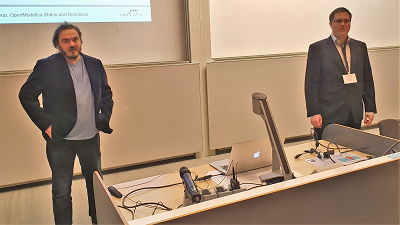
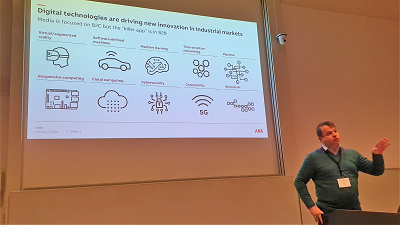
Left: Adrian Pop and Martin Sjölund, OpenModelica workshop chairpersons (Linköping University) opening the workshop.
Right: Rüdiger Franke, OSMC Chairman (ABB AG) presenting how digital technologies are driving new innovations in industrial markets.
This article is provided by Peter Fritzson Open Source Modelica Consortium
Report from MODPROD Workshop 2020
The 14th international MODPROD Workshop on Model-Based Cyber-Physical Product Development, organized by the MODPROD competence center at Linköping University, was successfully held at Linköping University, Linköping, Sweden, February 4-5, 2020.
Three tutorials were held in the morning the first day on the topics: Introduction to Modelica modeling, debugging, optimization/sensitivity analysis; FMI for composite modeling, co-simulation and model-exchange; Modeling and simulation of Power Systems with OpenModelica and the PowerGrids library.
Four keynotes were given:
- Peter Gorm Larsen, Professor at Aarhus University, Head of Digit Centre. “A Cloud-based Collaborative Platform for Model-Based development of Cyber-Physical Systems”
- Richard Romano, Professor at University of Leeds, Chair in Driving Simulation. “Model based design of Automated Vehicles”
- Gunnar Cedersund, Associate Professor at Linköping University, leader of Systems Biology group, “A digital twin for the human body: from data and validation to end-usage in healthcare and drug development”.
- Juan Llorens, Professor at the Informatics Dept., Univ of Madrid, President of INCOSE Spain, CTO of REUSE company. “Knowledge Management and reuse in the context of Systems Engineering”.
The program and the presentations are available at MODPROD website.

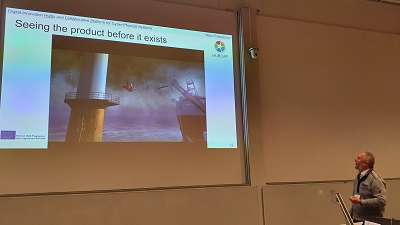
Left: Robert Braun and Ingo Staack (Linköping University), chairpersons.
Right: Peter Gorm Larsen (Aarhus University) gives his keynote on a cloud-based collaborative platform for CPS,including examples of digital twins.
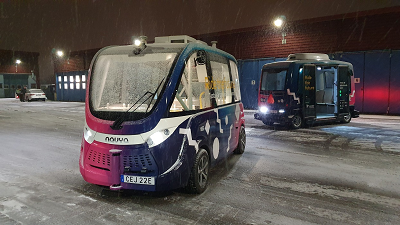
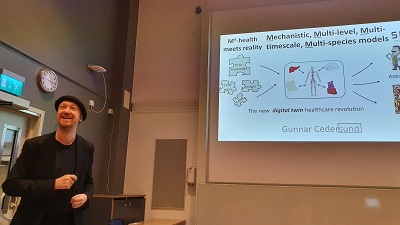
Left: Technical visit to the Road and Traffic Institute showing the project regarding self-driving buses at Linköping University campus.
Right: Gunnar Cedersund (Linköping University) presents his keynote including the new digital twin healthcare revolution – Mechanistic, Multi-level, Multi-timescale, Multi-species models.
This article is provided by Peter Fritzson Open Source Modelica Consortium
Vendor news
TLK DaVE - New version 2.0
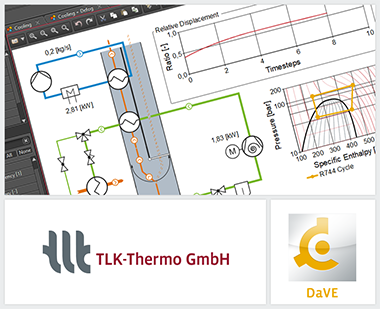
DaVE is a visualization and simulation environment that is suitable for both the post-processing and the online display of dynamic data. The current version 2.0 includes new developments and improvements, of which a small selection shall be mentioned here:
- Easy exchange of configurations: The “Pack Configuration” command creates a zip file that contains the configuration and the data files used. This ensures that all files are available when the configuration is exchanged. This also simplifies the backup of data.
- Executing mathematical operations: The new Data Connector “Calculation” offers the possibility to do simple mathematical operations (e.g. sum, differences, average values etc.). The results are then available as additional variables and can be used in the instruments.
- Extended StateChart instrument: The instrument “StateChart” has been extended by various functionalities. In addition to automatic isoline labeling, the “Multi-Edit” function has significantly reduced the time needed to configure point labels. Furthermore, a search filter for VLE media has been implemented and the selection of a standard medium has been added. In addition, various options for the visual enhancement of the instrument were implemented.
For further information see www.tlk-thermo.com, download the DaVE presentation or contact us at dave@tlk-thermo.com.
This article is provided by Roland Kossel TLK-Thermo GmbH
System Modeler and Mathematica 12.1 Released!
System Modeler and Mathematica 12.1 have been released earlier this month
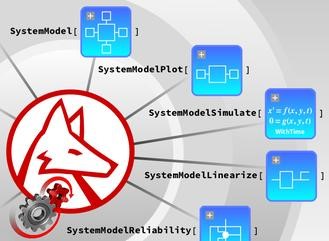
The latest version of System Modeler contains many new features to make your design process more efficient. Some of the highlights are:
- Better Error Reporting–Find and fix errors in your model with the addition of hyperlinks and easy-to-read errors and warning messages.
- Simplified Creation of Configurable Models–Easily create your configurable models with the improved user interface.
- Quickly Analyze Simulations–Find the plotted values for any point in time, or click and drag to select and compare plotted values between times using the new Measurement window.
Read more about the latest updates and download a trial here.
This article is provided by Ankit Naik Wolfram
OpenModelica 1.15.0 Beta1 Release
OpenModelica is the most complete open-source Modelica-based cyber-physical mathematical modeling, simulation and optimization environment intended for industrial and academic usage. Its long-term development is supported by a non-profit organization – the Open Source Modelica Consortium OSMC with many company, institute, and university members.
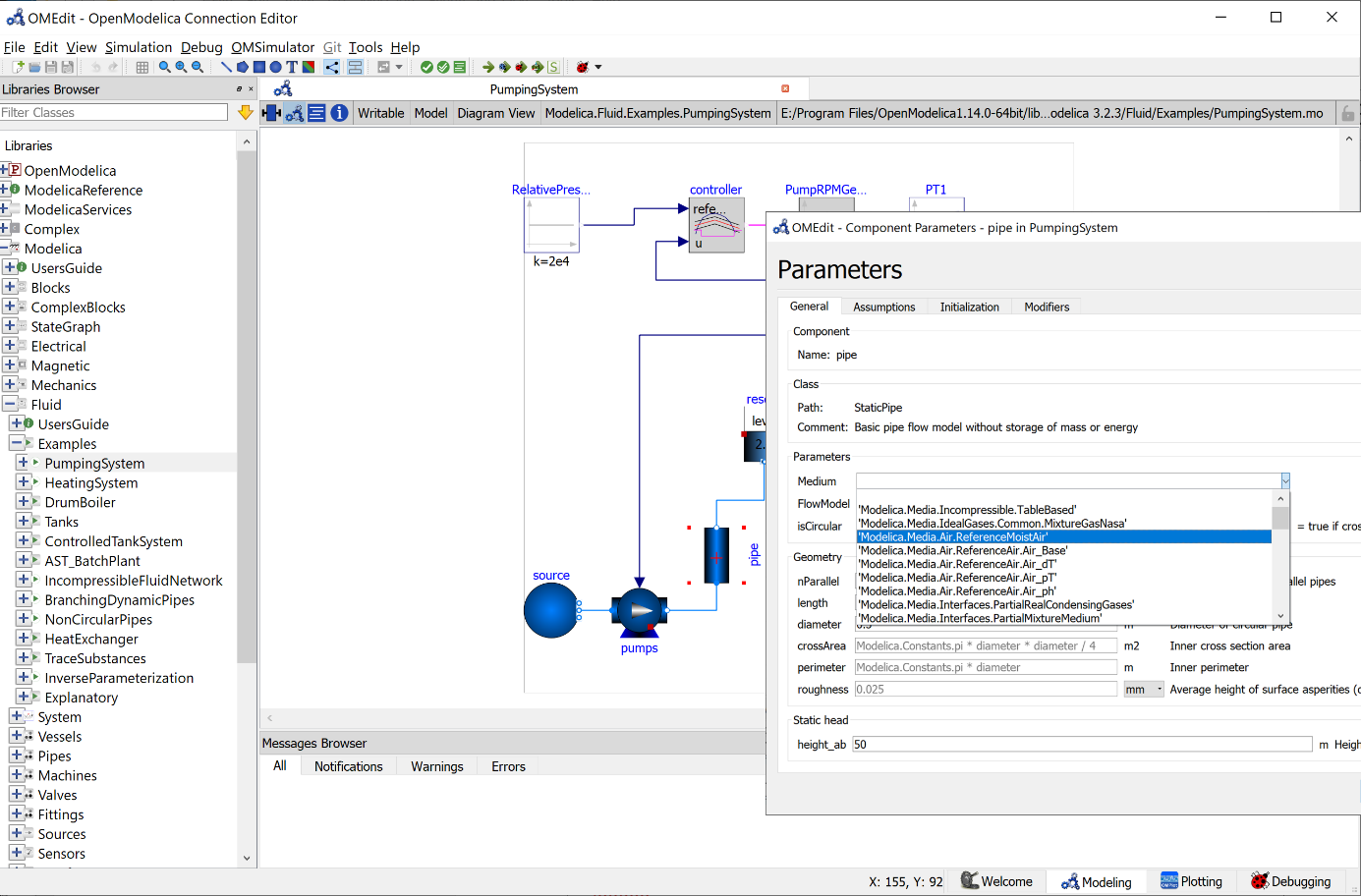
The figure shows OpenModelica while editing pump component inside PumpingSystem.
The OpenModelica 1.15.0 Beta1 release has been made available for testing. The main enhancement in this release is the graphical user interface support of replaceable items in libraries. The speed of the OMEdit GUI has also increased in this release.
This release is also using a further improved version of the OpenModelica Compiler New Frontend (NF), which on the average gives a factor of 10-20 speed improvement in the flattening phase of compilation compared to the old frontend. The new frontend is default also in this release. See www.openmodelica.org for download.
This article is provided by Peter Fritzson Open Source Modelica Consortium
Dymola 2021
Dymola 2021 will be generally available in May 2020. There are several key improvements in simulation performance and robustness. It is also possible to create snapshots of the result while simulating and to control the output interval from the model. Parameter sweeping can now handle more than two parameters. Furthermore, there are improvements in simulation analysis and profiling.
The new ribbon-based user interface that was introduced in Dymola 2020x has been further refined; the model tabs have been moved to the top of the model window. The plotting capabilities have been generalized to allow a matrix of plots in each window, and to provide additional result documentation for each plot window. A Moving Average operator allows smoothing of signals.
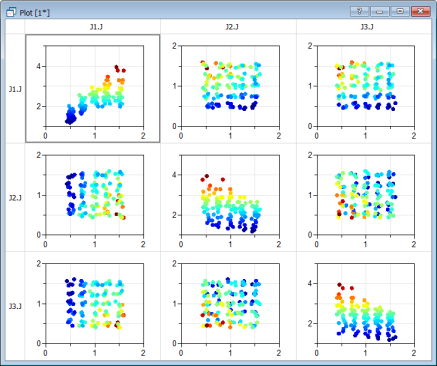
This article is provided by Dag Brück (Dassault Systemes)
News from libraries
TLK TIL Suite - New version 3.8.0
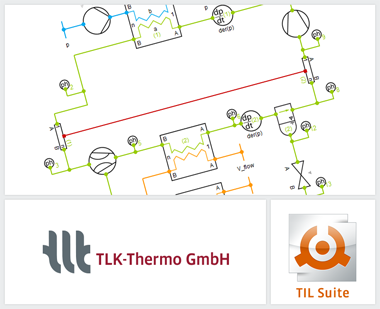
The TIL Suite is a comprehensive Modelica library for stationary and transient simulations of thermodynamic systems. The current version 3.8.0 contains the following innovations and improvements:
- Homotopy: The new version uses the Modelica Homotopy function in many TIL models. This function converts simplified model equations into the actual physical equations before the simulation starts, resulting in a very robust and stationary initialization. This alternative initialization method allows fast calculation of many different steady-state operating points within a parameter study. Furthermore, the homotopy initialization allows the simulation start from a defined stationary state at given boundary conditions.
- TIL 3.8.0 HD: The new variant of TIL “TIL HD” was developed for the calculation of highly dynamic simulations. The advantages are noticeable in case of strongly changing boundary conditions, switch-off and changeover processes with zero mass flows, controller tests and real-time simulation. With TIL HD the simulation of systems with changing modes of operation (e.g. switching between air conditioning and heat pump operation) is possible on the basis of a single FMU. Please contact us if you are interested.
For version 3.9.0, which will be released in April 2020, we would like to present a selection of the new features that will be featured in this release:
- New capillary tube model: With the new capillary tube model, the component library gets another representative from the area of valves. After only a few user inputs to parameterize the model, it is possible to simulate refrigeration cycles of refrigerator systems.
- New Examples: The “TIL Examples” are extended by several systems. For example, there will be a refrigerator system, which already contains the new capillary tube model, and a hydrogen filling station system, which uses the new substance data model TILMedia.Hydrogen.
For further information see www.tlk-thermo.com, download the TIL presentation or contact us at til@tlk-thermo.com.
This article is provided by Ingo Frohböse TLK-Thermo GmbH
TLK TILMedia Suite - New version 3.8.0
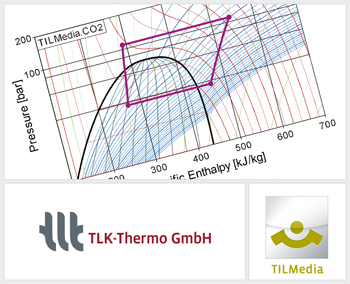
The TILMedia Suite provides calculation methods that describe the thermophysical properties of liquids, gases, real fluids with wet steam region and mixtures. These properties are calculated very quickly and accurately based on our optimized mathematical methods. Thanks to its many interfaces, TILMedia is available in various programs and languages (Dymola, SimulationX, Excel, LabVIEW, MATLAB, Simulink, Python, C++ and others).
The TILMedia Suite is continuously developed and contains several hundred different media models (R-134a, R-1234yf, CO2, humid air, water-glycol etc.) from different publications and sources, among them: TLK-Thermo, REFPROP, VDI Wärmeatlas, VDI 4670, CoolProp and NASA Glenn Coefficients.
The current version 3.8.0 provides besides speed improvements in substance data calculation also new features, of which a small selection shall be mentioned here:
- New substance data model for H2: The TILMedia Suite was extended by the VLEFluid model TILMedia.Hydrogen. With this model, substance properties e.g. for liquefaction or at high pressures (up to 1000bar) can be calculated according to scientific standards.
- Faster calculation of VLEFluid objects: The calculations of the partial density derivatives in VLEFluid objects can be deactivated, which results in a significantly higher overall calculation speed.
For further information see www.tlk-thermo.com, download the TILMedia presentation or contact us at tilmedia@tlk-thermo.com.
This article is provided by Christian Schulze TLK-Thermo GmbH
Education news
Wolfram Virtual Labs
Powering Engineering Education with Wolfram Virtual Labs
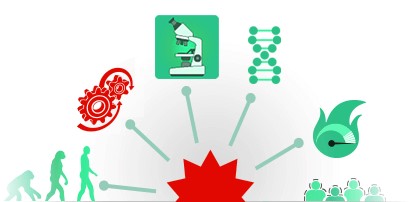
The following new Virtual Labs’ library is now available for download from the System Modeler library store:
CollegeBiology: Developed in collaboration with Linköping university contains interactive biology labs related to PCR, electrophoresis and autosomal recessive disease.
The labs are developed using Mathematica notebooks with Modelica models running in the background. For more information please read this blog.
Click here to read the latest System Modeler news.
This article is provided by Ankit Naik Wolfram
Modelon Blog - Leverage Standardized Encryption and Licensing for Modelica Libraries

Open Source Encryption Standard Designed by Modelon
SEMLA (Standardized Encryption of Modelica Libraries and Artifacts) is a system for distributing proprietary Modelica libraries which supports:
- Encryption
- Licensing
- Secure decryption of encrypted Modelica libraries
- Platform independence Libraries are bundled in the MLC (Modelica Library Container) format, which are zip files containing the encrypted libraries and a manifest. SEMLA was designed by Modelon developers to be an open source encryption standard, which allows library vendors to protect the intellectual property contained within their Modelica libraries. SEMLA can also prevent libraries from being copied and re-used by other Modelica users unless authorized by the library vendor.
SEMLA Interface
The SEMLA protocol allows a library vendor to access licensed and encrypted Modelica libraries via an LVE (Library Vendor Executable) interface, using a secure communication channel. The LVE is controlled by the library vendor and allows the vendor to choose which licensing and encryption schemes, if any, will be implemented in the protocol. The communication channel is secured with an SSH 1.1 connection. This connection allows the LVE to communicate with a single or multiple authenticated Modelica tools. The library vendor can also create different LVE interfaces for each of their customers, with different licensing and encryption parameters for each instance, if so desired. The SEMLA system also includes source code for a platform-independent utility called packagetool. The packagetool utility can be used to scan the Modelica libraries, encrypt the contents and create the MLC.
Learn More about the SEMLA Protocol
The SEMLA protocol is an open source project. Modelon has documented detailed specifications for the protocol in Tool-Independent Licensing and Encryption of Modelica Libraries.
This article is provided by Jocelyn Paslowski, Modelon